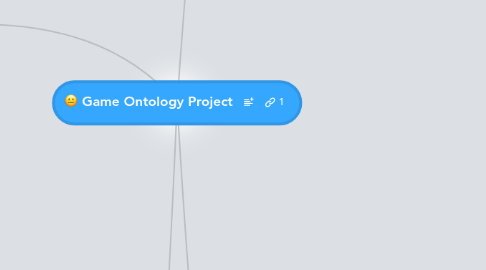
1. Interface
1.1. Input
1.1.1. Input Devices
1.1.1.1. Analog Pushbutton
1.1.1.2. Digital Pushbutton
1.1.1.3. Direction Pad
1.1.1.4. Fourward Joystick
1.1.1.5. Lightgun
1.1.1.6. Rotary Paddle Control
1.1.1.7. Thruster (two-way) Joystick
1.1.1.8. Touch-Sensitive Screen
1.1.1.8.1. Stylus pen
1.1.1.9. Microphone
1.1.2. Input Methods
1.1.2.1. Locus of Manipulation
1.1.2.1.1. Multiple Entity Manipulation
1.1.2.1.2. Single Entity Manipulation
1.1.2.2. Manipulation Method
1.1.2.2.1. Direct Manipulation
1.1.2.2.2. Indirect Manipulation
1.2. Presentation
1.2.1. Cardinality Of Gameworld
1.2.1.1. 1-Dimensional Gameworld
1.2.1.2. 2-Dimensional Gameworld
1.2.1.3. 3-Dimensional Gameworld
1.2.1.4. Undefined Gameworld Cardinality
1.2.2. Presentation Hardware
1.2.2.1. Audio Display Hardware
1.2.2.2. Haptic Display
1.2.2.2.1. Closed Cycle Haptics
1.2.2.2.2. Open Cycle Haptics
1.2.2.3. Visual Display Hardware
1.2.2.3.1. Video Monitor
1.2.2.3.2. VR Goggles
1.2.3. Presentation Software
1.2.3.1. Feedback
1.2.3.1.1. Confirmation
1.2.3.1.2. Warning
1.2.3.2. Point Of View
1.2.3.2.1. First-person Point of View
1.2.3.2.2. Second-person Point of View
1.2.3.2.3. Third-person Point of View
1.2.3.3. Sensory Output
1.2.3.3.1. Aural Output
1.2.3.3.2. Tactile Output
1.2.3.3.3. Visual Output
2. Goals
2.1. Agent Goals
2.2. Game Goals
2.2.1. Optional Goals
2.2.1.1. Collectables
2.2.1.2. Side-Quest
2.2.2. Required Goals
2.3. Goal Metrics
2.3.1. Performance Record
2.3.2. Score
2.3.3. Success Level
2.3.4. Time
3. Rules
3.1. Rules Synergies
3.1.1. Complete Information
3.1.2. Dominant Strategy
3.1.3. Dynamic Difficulty Adjustment
3.1.4. Economies of Scale
3.1.5. Economies of Scope
3.1.6. Incomplete Information
3.1.7. Intransitive Relationships
3.1.8. Transitive Relationships
3.2. Gameplay Rules
3.2.1. Cardinality of Gameplay
3.2.1.1. 0-Dimension Gameplay
3.2.1.2. 1-Dimensional Gameplay
3.2.1.3. 2-Dimensional Gameplay
3.2.1.4. 3-Dimensional Gameplay
3.2.2. Game Ends
3.2.2.1. Evaluation of Ending
3.2.2.2. Gameworld Exhaustion
3.2.2.3. Narrative Exhaustion
3.2.2.4. Resource Exhaustion
3.2.3. Lives
3.2.4. Multiplayer
3.2.4.1. Cooperative Multiplayer
3.2.5. No Game End
3.2.6. Player Manipulable Rules
3.2.6.1. Difficulty Levels
3.2.6.2. Character customization
3.2.7. Randomness
3.2.8. Segmentation of Gameplay
3.2.8.1. Challenge Segmentation
3.2.8.1.1. Boss Challenge
3.2.8.1.2. Bonus Stage
3.2.8.1.3. Puzzle
3.2.8.1.4. Wave
3.2.8.1.5. Mission
3.2.8.2. Spatial Segmentation
3.2.8.2.1. Level
3.2.8.2.2. Spatial Checkpoint
3.2.8.3. Temporal Segmentation
3.2.8.3.1. Temporal Coordination
3.2.8.3.2. Temporal Resource
3.2.8.4. Narrative Segmentation
3.3. Gameworld Rules
3.3.1. Checkpoint
3.3.2. Cropping
3.3.3. Expiration
3.3.4. Pseudo-Physical Rules
3.3.4.1. Gravity
3.3.4.2. Life Support
3.3.4.3. Solidity
3.3.4.4. Persistent Gameworld (proposed)
3.3.5. Savepoint
3.3.6. Spawnpoint
4. Entity Manipulation
4.1. Compound Action
4.1.1. To Manage Resources
4.1.2. To Shoot
4.1.3. To Transport
4.2. To Collide
4.3. To Create
4.3.1. To Generate
4.4. To Move
4.4.1. To Evade
4.4.2. To Teleport
4.4.3. To Traverse
4.4.4. To Visit
4.5. To Own
4.5.1. To Capture
4.5.2. To Exchange
4.5.2.1. To Transfer
4.5.3. To Possess
4.5.3.1. To Collect
4.5.3.2. To Release
4.6. To Remove
4.7. To Rotate
4.8. To Select
4.8.1. To Target
4.9. To Manipulate Time
4.9.1. To Start Time
4.9.2. To Pause Time
4.9.2.1. To Pause Time with Gameworld Agency
4.9.2.2. To Pause Time without Gameworld Agency
4.9.2.2.1. To Save
4.9.3. To Rewind Time
4.9.3.1. To Undo Time
4.9.4. To Fast Forward Time
4.9.4.1. To Skip Time
4.9.5. To Accelerate Time
4.9.6. To Decelerate Time
4.9.7. To Localize Time
4.10. To Manipulate Gravity
4.11. To Customize
4.11.1. In-game Customization
4.11.2. Customization via Game Menu
4.11.3. Extra-game Customization

